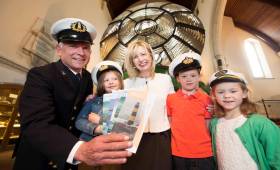Displaying items by tag: May Bank Holiday Festival
Visit Great Lighthouses of Ireland to Shine a Light on Summer!
#GreatLighthouses - This May Bank Holiday (30 April-2 May) kick start your summer and get out to visit the Great Lighthouses on this island for a weekend of fun, discovery, stories and thrills.
Walk through time, meet fifth-century monks, medieval Knights, discover all about the life of Lighthouse keepers at Hook Lighthouse on their new Ireland’s Ancient East tour experience, hear the tales of wrecks and lifesaving feats, as well as having ceol agus craic at Fanad - voted one of the most beautiful lighthouses in the world.
Take guided tours of Loop Head Lighthouse and its award winning peninsula and return for a feast of seafood and fun.
Tie nautical knots and welcome back the puffins as they clown around squawking and sea diving at Rathlin West Light Seabird Centre. Enjoy a traditional music session in the lighthouse keeper’s dwelling house and watch helicopter sea rescue manoeuvres at Valentia Island Lighthouse.
Hear the Singing Sistas at Clare Island Lighthouse and listen to the tales and stories of Lighthouse Keeping on Ballycotton Island. Get tips on being safe and enjoying our coast this summer, explore our towers, discover their hidden secrets and much more.
For hundreds of years lighthouses have helped seafarers find their way. Now they shine their light on truly unique experiences around our stunning coastline.
Great Lighthouses of Ireland (www.greatlighthouses.com) invites visitors and friends to a feast of storytelling, music, workshops and of course tower tours in seven of our amazing lighthouses along the Wild Atlantic Way, Ireland’s Ancient East and all the way to Rathlin Island. A fun-filled weekend is promised.
Coastal partners and organisations such as Royal National Lifeboat Institute (RNLI), Coastguard and others will be onsite for demonstrations and talks in many of the locations.
This will be a special opportunity to get behind the scenes with experts from Irish Lights and learn about technology and navigation today. Local historians and Storykeepers will provide tours that showcase the natural and cultural highlights.
Yvonne Shields, Chief Executive of Irish Lights said; “Our visitors tell us that getting to the top of a lighthouse tower is a unique and special experience. This weekend we are encouraging everyone to come and enjoy all that the Great Lighthouses of Ireland has to offer. Irish Lights is delighted to support our partners to showcase the best of these locations.
Lighthouse keeping was a way of life for keepers and their families for well over 100 years. However, advances in technology meant that lighthouses could be automated, and while all our lighthouses are still fully operational, there is no longer a need for permanent lighthouse keepers to be stationed on site. Great Lighthouses of Ireland is a wonderful way of keeping this rich maritime heritage, and the legacy of these Lighthouse Keepers, alive.”
Great Lighthouses of Ireland is a new and exciting collaboration between many private and public organisations in coastal communities. The experience has been developed to build on the momentum of the Wild Atlantic Way and Ireland’s Ancient East and this event is supported by Fáilte Ireland.
Speaking at the opening of Fanad Head Lighthouse on Friday 29th April, Shaun Quinn CEO of Fáilte Ireland welcomed the inaugural Shine a Light on Summer Festival.
“Whether it’s Hook in Wexford, Valentia Island in Kerry, Loop Head in Clare, Fanad Head in Donegal or the Island Lighthouse towers in Cork and Mayo, this is the weekend to discover that part of Irish life and culture where the land meets the sea. We in Failte Ireland are delighted to support this event as it encourages visitors to embrace an authentic piece of our Irish past and to meet with the people and communities who are passionate about these unique places”
As Gerald Butler, Former Lighthouse Keeper & Current Lighthouse Attendant at Galley Head Lighthouse says, “It wasn’t a job – it was a way of life”
For event details and information about and booking Great Lighthouses of Ireland visit:www.greatlighthouses.com





























































